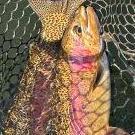Knowing the plans for preventing floods in the spring can improve your chances of catching wintertime bass on Lake of the Ozarks.
AmerenMissouri annually draws down lake levels during the winter to prevent flooding in the spring, so Lake of the Ozarks anglers must adapt to the falling water to catch bass.
A typical winter drawdowns usually leads to three phases that anglers must adjust to in order to keep track of bass throughout the winter and early spring. Phase One occurs when the drawdown begins and bass move from the shallows to deeper sanctuaries. Next comes Phase Two when the drawdown bottoms out and bass bunch up in certain holes during the dead of winter. Phase Three follows in early spring when the lake is still low and shoreline cover is high and dry, but bass have the urge to move shallower in search of warmer water.
Here’s a look at how FLW Tour pro and Lake of the Ozarks guide Casey Scanlon tracks and catches Lake of the Ozarks bass during each phase of the winter drawdown.
Phase One
The first drawdown phase on Lake of the Ozarks usually starts slowly in late November or early December and then Scanlon notices the water levels drop sharply at some point. Scanlon keys on main and secondary points where bass are feeding on larger meals for winter. “Those fish are up there eating those big (gizzard) shad,” he said.
During the early stages of the drawdown, Scanlon relies on a Luck E Strike Buzzbait or other topwater lures to catch bass chasing the gizzard shad. As the lake level continues to fall, bass start suspending on points and vertical structure on the main lake so Scanlon tempts these fish with a Luck E Strike RC STX Jerkbait or a 3/4-ounce spinnerbait that he slow rolls.
Phase Two
The guts of creeks and main lake pockets are Scanlon’s favorite targets during the bottom-out stage of the winter drawdown. He finds Lake of the Ozarks bass suspending at 8 to 10 feet over a depth of 20 feet or greater and casts his lures down the middle of the guts. “In the middle of winter, I use a (suspending) jerkbait and I am also going to throw some kind of an Alabama rig.” He throws an Alabama rig without blades in clear water on calm, sunny days but changes to a bladed version of the rig in windy or cloudy conditions.
Phase Three
This is the trickiest phase of the drawdown since bass want to move to warmer water in the shallows, but shallow cover is sparse and cold fronts can send bass retreating back to deeper water.
Scanlon concentrates on boulders and docks in the shallows along points and bluffs in the backs of creeks. “I look for just any type of cover available on the bank and I will throw a (1/2-ounce Trophy Bass Company) jig with a big trailer to slow the fall rate down,” Scanlon said. He also throws a suspending jerkbait and a Luck E Strike G5 crankbait for bass suspended in deeper water.
For information on lodging and other facilities at the Lake of the Ozarks or to receive a free vacation guide, call the Lake of the Ozarks Convention & Visitors Bureau at 1-800-FUN-LAKE or visit the Lake of the Ozarks Convention and Visitors Bureau web site at funlake.com.
For copies of John Neporadny’s THE Lake of the Ozarks Fishing Guide call 573/365-4296 or visit www.jnoutdoors.com.
Reprinted with permission from B.A.S.S. Publications



Recommended Comments
Create an account or sign in to comment
You need to be a member in order to leave a comment
Create an account
Sign up for a new account in our community. It's easy!
Register a new accountSign in
Already have an account? Sign in here.
Sign In Now